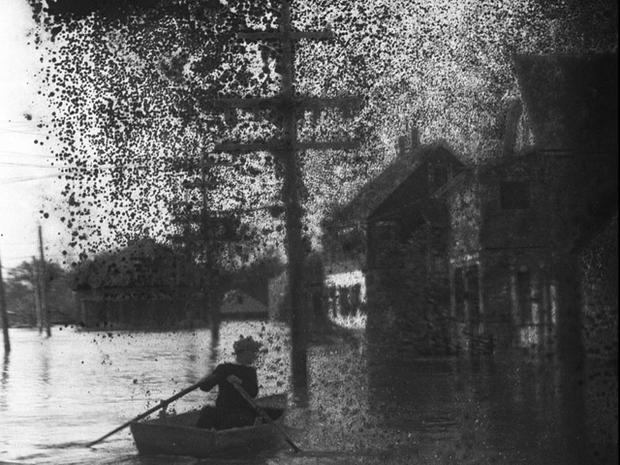Movie Blog: Bill Morrison Uses Film Decay To Create Life
Forget George A. Romero. Bill Morrison is the foremost zombie movie filmmaker, albeit one who works exclusively in avant-garde form.
Morrison could technically be called a "found footage" artist, though his archival discoveries are less focused on scarcity and more on something that's likely all too prevalent among the already few films from motion pictures' first few decades. His work is fascinated by the decomposition of ancient prints.
If the monumental symphony of audio-visual destruction Decasia is his Citizen Kane, it's worth noting that he has a whole body of shorter works that dance around the many forms of death cinema is capable of not only simulating, but full-out embodying. In gorgeous, ethereal films like Light is Calling, one form of death becomes a stepping stone toward a gorgeous form of reincarnation. This is some of the most dazzling morticians' work you're likely to ever see.
Morrison will be on hand to discuss his body of work at the Walker Art Center later this week. I interviewed Morrison in anticipation of the series, focusing on his love for all things gorgeously broken. Here are some excerpts from our talk.
-------
Much is made in the world of horror about "found footage," and yet your film Decasia feels like the ultimate found footage horror film.
Maybe that's because it's actually real. The term "found footage" has been corrupted in the strangest way, as "badly filmed fiction."
Can you talk a little bit about the nature of digital vs. analog decomposition, in terms of your work?
That's kind of an ironic question, because a lot of the Walker presentation will be digital captures, or digital scans of films that were originally analog. I can't claim to be an analog purist.
But some have said that movies in digital form, thanks to disc rot, have an even shorter shelf life than traditional film.
Did you read Dave Kerr's article on Decasia? He actually explores that in depth, and created quite a bit of chatter on the topic. The decay that you see in Decasia is all random, it's all organically formed due to the chemical decomposition of the image. And so therefore it's sort of out of my control. The extent that it's in my control is only as a curatorial choice, finding those instances where material, conditions and image have sort of conspired to create an aberration. I'm most interested when that aberration interacts with the image rather than just obscuring it. So, that's sort of the first filter in looking for imagery -- what's decayed, and then from that, where will be likely to find instances where it would be depicting a human sort of struggling with the limits of their body or their casing, in much the same way as the film is struggling with its casing or its skin? And then do those two things interact in an interesting way? I don't know if the same thought processes are at work with digital decay. There's so many permutations of analog decay. Even within the case of Decasia, where you're looking at mostly nitrate decay (though there's a sequence of 16mm acetate water damage), there's a cornucopia of different patterns and ways that it can decay, things that happen to the emulsion and the base. With digital media, it's much less forgiving. There's 1's and 0's and you don't have anything in between. Yes, you can have a glitch, but then you drop picture altogether. I'm not sure that lends itself to the same sort of romantic interpretation.
It is interesting how many different decomposition types there are in Decasia, with the selective erasure of the missing boxer, those warped stretch marks turning faces into ectomorphic nightmare masks. And then I remember the scene with the nuns walking where it resembles a strobe-lit stained-glass window.
Yeah, there was actually some solarization at work there. It's all dependent on the material or the stock the film was originally printed on and the conditions it was in after. There's a lot of chaos that goes into what creates it. I organize my bins according to decay, and sort of have pet names for describing them. I remember one of them I called "Matisse Jazz Shapes."
We're just releasing Michael Haneke's new film Amour in town this week. The title implies love, but the content depicts without any sentimentality the process of death. There's a similar emotional contrast going on in the earliest film of yours showing at the Walker next week, A Film of Her. Can you talk about that contrast?
A Film of Her is a set-up for the rest of my career. Those films were safe because they were printed on paper, because there was an arcane copyright law that treated films the same way as photographs. So the way around that copyright law was to make unwatchable paper prints that could be copyrighted as photographs. Legislation caught up with the media in 1912 and at that point you were no longer required to make these paper rolls, and people could just deposit frames or descriptions to protect their films. And we lost all those films after that. The irony is that the ones that were stored on paper were saved, and the negatives for those films and many others during that time and afterwards were lost to warehouse fires and the like, or just bad storage as we see in Decasia. A Film of Her is sort of a strange survivor story, and it sort of sets an early history of the evolution of the medium. And that's another interesting thing about film, that we have a "beginning." We have a place where we can say this is the "Eureka moment." Edison's sneeze, or wherever you want to place it within five years of that, before which there was not film and after there was cinema. A Film of Her is a parallel to that consciousness, or the evolution of a cinema "man," who evolved and dreamed and grew up with cinema and, increasingly, in reaction to cinema. A Film of Her sort of sets the stage for that and Decasia is more of a middle-aged interpretation of the same thing.
Can I ask a very Entertainment Weekly question?
Sure.
Which films would you prefer to see decay?
Well, this goes back to the digital question. Most of the films we know today are acetate now, so the way that they would decay would be very boring. They would sort of turn pink.
Sort of like an Instagram filter?
Worse. We're all familiar with those 16mm films we saw in school, and how they were scratched and pink. That's sort of the fate of all acetate films. That's why they have to do reprints of Star Wars every 20 years. It's sort of taking one candle to the next. They're all decaying, but they're just not decaying in a spectacularly chaotic way that nitrate is. And I wouldn't waste any nitrate film to decay more than it already has. I think that would be a cruel wish.





